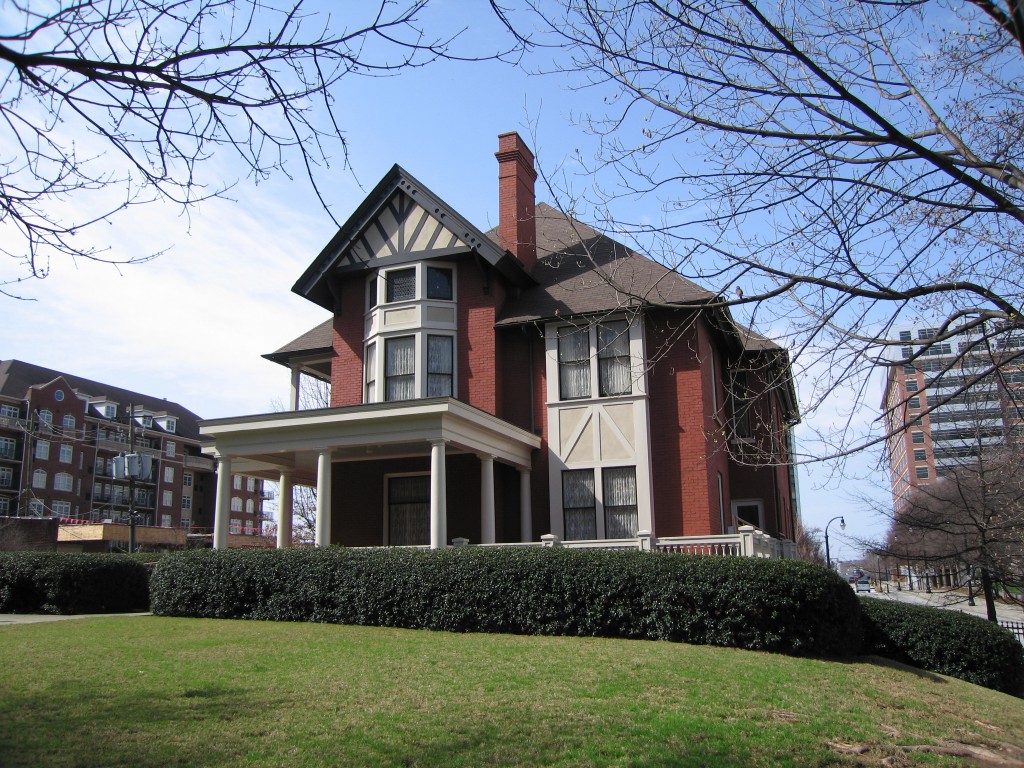Atlanta’s original TDR ordinance was designed to preserve buildings of historical cultural significance. Following amendments to Section 16-28.023 in 1995, 2004, and 2017, the purpose has expanded to allow the preservation of affordable housing and natural and environmental as well as historic resources. Sending areas must now meet any of four criteria.
- Residential sending areas: A lot or combination of contiguous which is partly zoned for single-family or two-family residential (R-1 through R-5) and partly zoned for multiple-family residential (RG or General Residential) but used exclusively for single-family or two-family residential.
- Properties designated as a landmark building or site or as a historic building or site by the Atlanta Historic Preservation Ordinance.
- One or more parcels preserved as greenspace.
- One or more lots or parcels providing affordable workforce housing units.
Atlanta’s TDR program has preserved four historic landmarks to date, including the house where Margaret Mitchell wrote Gone with the Wind, pictured here.
The ordinance adds that sending properties have special characteristics including but not limited to woodland, floodplain, habitat, wetland, groundwater recharge, marsh hammocks, recreation areas and parkland including golf courses; or land with unique aesthetic, architectural or historic value “…that is found by the governing body to be deserving of protection from future development and which will be dedicated to that use when the development rights are severed…”.
The Atlanta ordinance uses the term “development factors” to refer to the three development rights that may be severed and transferred: floor area ratio, total open space, and useable open space.
Under the original ordinance, the sending and receiving sites had to be “under close proximity to one another” and the owners of these properties had to jointly apply for a special permit to transfer development rights. The current ordinance still provides for a joint application process when parcels are contiguous and proposed for development under common ownership. But sending and receiving sites are no longer required to be close to one another. Now receiving sites must simply be zoned for multi-family residential or mixed uses provided that residential represents at least 50 percent of the project. Using a special permit process, the governing body must determine that the receiving site is appropriate for the bonus development and that the transfer will not cause substantially adverse environmental, economic or social impacts.
When an applicant proposes a residential sending site, development rights are generated only by that portion of the site zoned for multiple-family residential. After the development rights have been transferred, the sending site can only be used for the single-family or two-family residential purposes allowed by the zoning of the other portion of the property. Residential sending sites can only send development rights to residential receiving sites.
When the sending site is a designated landmark or historic site, the transferable development is the development potential of the site minus the landmark building’s existing development.
Greenspace sending sites must meet the definition in O.C.G.A. 36-22-2(3). If the City buys the property after its development rights have been transferred, the purchase price must reflect that value reduction as determined by an appraisal. The ordinance states that the restrictions recorded on sending sites cannot be restored by subsequent rezonings if any occur.
In 1991, the City used TDR to permanently protect a significant landmark known as “The Castle” located on Fifteenth Street (87 Fifteen Street, N.W.) in what is known as the Midtown area of Atlanta. The Castle was designed and built in 1909-10 by Ferdinand D. McMillan, an eccentric businessman who succeeded in creating an architecturally unique home. In this transfer, a Special Use Permit for a Transfer of Excess Development Rights was granted to AT&T Resource Management Corporation for a receiving site located at an adjacent site on Fourteenth Street. Almost 80,000 square feet of development rights were transferred from The Castle to the 800,000 square-foot office tower. The transfer was documented in a recorded agreement that specifies the restrictions against alteration or demolition of The Castle.
In 2001, Karen Huebner, Executive Director of the Atlanta Urban Design Commission, explained that the TDR program may be hampered by the relatively high densities permitted by right under current zoning in Atlanta’s Central Business District. If developers can achieve desired densities by right, there is little incentive to take on the added burden of requesting a special permit to transfer excess development rights from a historic property. The transfer that saved The Castle was helped by the fact that permissible density is lower in Atlanta’s Midtown area creating a demand for transferable development rights in order to exceed these more restrictive limits.
In addition to the Castle, the TDR ordinance has been used to preserve the following three landmarks.
- Margaret Mitchell House, 979 Crescent Avenue, N.W., is the popular name of the Windsor House Apartments, a three-story, brick veneer structure built in 1898. The author began writing Gone with the Wind when she and her husband lived here between 1926 and 1932.
- Academy of Medicine, 875 West Peachtree Street, N.W., is a Neo-Classical structure built in 1941.
- Edward C. Peters House, 179 Ponce de Leon Avenue, N.E., is a red brick, High Queen Anne Victorian mansion built in 1883.

